-
![George Cruikshank : A Catalogue Raisonné Of The Work Executed During The Years 1806-1877; With Collations, Notes, Approximate Values, Facsimiles, And Illustrationsby Albert M. Cohn, author of a bibliographical catalogue of the printed works illustrated by George Cruikshank, etc. London : Office of "The Bookman's Jounral", 1924. [Cohn, Albert M.]](https://varshavskycollection.com/wp-content/uploads/2021/02/LIB-1650-c-scaled-500x500.jpg) GEORGE CRUIKSHANK | A CATALOGUE RAISONNÉ | OF THE WORK EXECUTED | DURING THE YEARS 1806-1877 | WITH COLLATIONS, NOTES, APPROXIMATE VALUES, | FACSIMILES, AND ILLUSTRATIONS | BY | ALBERT M. COHN | Author of A Bibliographical Catalogue of the Printed | Works Illustrated By George Cruikshank, etc. | LONDON |FROM THE OFFICE OF "THE BOOKMAN'S JOURNAL" | 7 HENRIETTA STREET, STRAND, W.C.2 | 1924. Pagination: ffl, [i, ii] – h.t. / Limited edition (122 of 500), [2] – blank / frontis. lith. portrait of G. Cruikshank w/guard, [iii, iv] – t.p. / printed in G.B., [v, vi] – dedicat. / blank, vii-xvi; [1, 2] – f.t. / blank, 3-375, [376] – Imprint., bfl; 31 leaves of plates, some mounted. Binding: size 30 x 24 x 5.5 cm, hardcover, bevelled boards, original brown cloth with gilded lettering to spine. Top edge gilt, other untrimmed; printed on laid paper. To front pastedown: "Ex libris – Fred Robison Heryer" (round, 55 mm, resembles a coin, printed on heavy gold-coloured foil with embossed lettering and an image of a seated man lettered ALEXANDROY in Greek. To back pastedown: Seller's sticker "From the book of J.W.Robinson Co., Seventh & Grand, Los Angeles." J. W. Robinson Co. – a chain of department stores, established by Joseph Winchester Robinson (American, 1846 – 1891). Some Fred Robison Heryer (American, 1907 – 1992) died in Kansas.
GEORGE CRUIKSHANK | A CATALOGUE RAISONNÉ | OF THE WORK EXECUTED | DURING THE YEARS 1806-1877 | WITH COLLATIONS, NOTES, APPROXIMATE VALUES, | FACSIMILES, AND ILLUSTRATIONS | BY | ALBERT M. COHN | Author of A Bibliographical Catalogue of the Printed | Works Illustrated By George Cruikshank, etc. | LONDON |FROM THE OFFICE OF "THE BOOKMAN'S JOURNAL" | 7 HENRIETTA STREET, STRAND, W.C.2 | 1924. Pagination: ffl, [i, ii] – h.t. / Limited edition (122 of 500), [2] – blank / frontis. lith. portrait of G. Cruikshank w/guard, [iii, iv] – t.p. / printed in G.B., [v, vi] – dedicat. / blank, vii-xvi; [1, 2] – f.t. / blank, 3-375, [376] – Imprint., bfl; 31 leaves of plates, some mounted. Binding: size 30 x 24 x 5.5 cm, hardcover, bevelled boards, original brown cloth with gilded lettering to spine. Top edge gilt, other untrimmed; printed on laid paper. To front pastedown: "Ex libris – Fred Robison Heryer" (round, 55 mm, resembles a coin, printed on heavy gold-coloured foil with embossed lettering and an image of a seated man lettered ALEXANDROY in Greek. To back pastedown: Seller's sticker "From the book of J.W.Robinson Co., Seventh & Grand, Los Angeles." J. W. Robinson Co. – a chain of department stores, established by Joseph Winchester Robinson (American, 1846 – 1891). Some Fred Robison Heryer (American, 1907 – 1992) died in Kansas. -
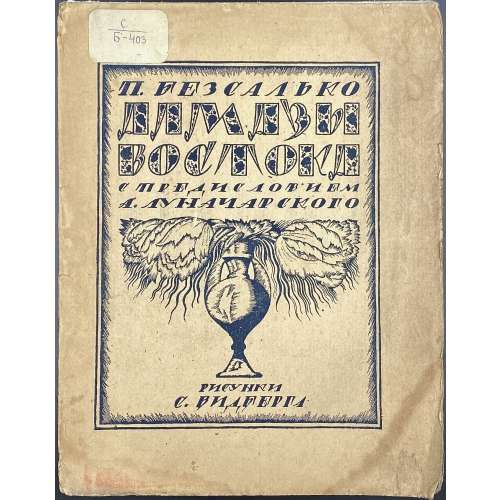 Publisher’s pictorial wrappers, to front wrapper in frame “П. БЕЗСАЛЬКО | АЛМАЗЫ | ВОСТОКА | С ПРЕДИСЛОВИЕМ | А. ЛУНАЧАРСКОГО | {vignette vase with flowers} | РИСУНКИ | С. ВИТБЕРГА || Ex-library book with stamps and stickers. Title page: П. БЕЗСАЛЬКО | АЛМАЗЫ | ВОСТОКА | {publisher’s device «КНИГОИЗДАТЕЛЬСТВО ПЕТРОГРАДСКОГО СОВДЕПА / КНИГА НАРОДУ» | Издание Петроградского Совета | Рабочих и Красн. Депутатов | 1919 || Pagination: [1-4] 5-85 [3], total 88 pages, 12 full-page black and white plates. Collation: 8vo; [1]-58 64, total 44 leaves, plates within collation. Contributors: Безсалько, Павел Карпович (Russian, 1887 – 1920) – author. Луначарский, Анатолий Васильевич (Russian, 1875 – 1933) – author if the foreword. Vidbergs, Sigismunds (Latvian-American, 1890 – 1970) – artist. Бельгова, Полина Борисовна (written "ПОЛИНА БОРИСОВНА ЬЕЛЬГОВА") – dedicatee, unidentified.
Publisher’s pictorial wrappers, to front wrapper in frame “П. БЕЗСАЛЬКО | АЛМАЗЫ | ВОСТОКА | С ПРЕДИСЛОВИЕМ | А. ЛУНАЧАРСКОГО | {vignette vase with flowers} | РИСУНКИ | С. ВИТБЕРГА || Ex-library book with stamps and stickers. Title page: П. БЕЗСАЛЬКО | АЛМАЗЫ | ВОСТОКА | {publisher’s device «КНИГОИЗДАТЕЛЬСТВО ПЕТРОГРАДСКОГО СОВДЕПА / КНИГА НАРОДУ» | Издание Петроградского Совета | Рабочих и Красн. Депутатов | 1919 || Pagination: [1-4] 5-85 [3], total 88 pages, 12 full-page black and white plates. Collation: 8vo; [1]-58 64, total 44 leaves, plates within collation. Contributors: Безсалько, Павел Карпович (Russian, 1887 – 1920) – author. Луначарский, Анатолий Васильевич (Russian, 1875 – 1933) – author if the foreword. Vidbergs, Sigismunds (Latvian-American, 1890 – 1970) – artist. Бельгова, Полина Борисовна (written "ПОЛИНА БОРИСОВНА ЬЕЛЬГОВА") – dedicatee, unidentified. -
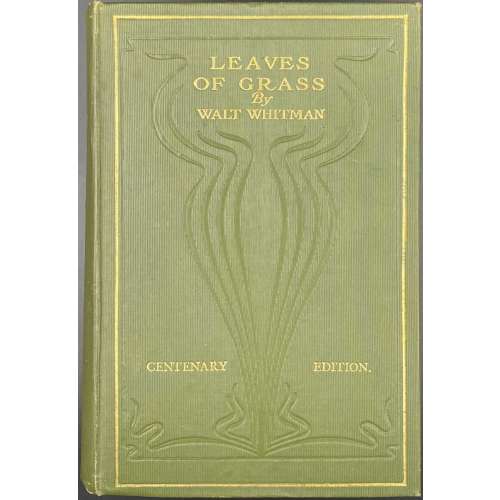 Hardcover, 21.5 x 15 cm, green buckram with gilt border and gilt lettering to front board and spine, blind decorated in art nouveau style, T.E.G. Pagination: [26] 1-294, [4] 1-323 [324], [4] 1-255 [256] [4]; total 912 pages and photo portrait frontispiece. Title-page: THREE VOLUMES IN ONE | LEAVES OF GRASS| WALT WHITMAN | ISSUED UNDER THE | EDITORIAL SUPERVISION OF HIS | LITERARY EXECUTORS, RICHARD MAURICE | BUCKE, THOMAS B. HARNED, AND | HORACE L. TRAUBEL | {device} | D. APPLETON AND COMPANY | New York […] London || For the Russian translation, see LIB-3103.2022 Уолт Уитмен. Листья травы / Пер. с англ. Вступ. статьи К. Чуковского и М. Медельсона. — М.: Государственное издательство художественной литературы, 1955. Contributors: Walter [Walt] Whitman (American, 1819 – 1892) Richard Maurice Bucke (Canadian, 1837 – 1902) Thomas Biggs Harned (American, 1851 – 1921) Horace Logo Traubel (American, 1858 – 1919)
Hardcover, 21.5 x 15 cm, green buckram with gilt border and gilt lettering to front board and spine, blind decorated in art nouveau style, T.E.G. Pagination: [26] 1-294, [4] 1-323 [324], [4] 1-255 [256] [4]; total 912 pages and photo portrait frontispiece. Title-page: THREE VOLUMES IN ONE | LEAVES OF GRASS| WALT WHITMAN | ISSUED UNDER THE | EDITORIAL SUPERVISION OF HIS | LITERARY EXECUTORS, RICHARD MAURICE | BUCKE, THOMAS B. HARNED, AND | HORACE L. TRAUBEL | {device} | D. APPLETON AND COMPANY | New York […] London || For the Russian translation, see LIB-3103.2022 Уолт Уитмен. Листья травы / Пер. с англ. Вступ. статьи К. Чуковского и М. Медельсона. — М.: Государственное издательство художественной литературы, 1955. Contributors: Walter [Walt] Whitman (American, 1819 – 1892) Richard Maurice Bucke (Canadian, 1837 – 1902) Thomas Biggs Harned (American, 1851 – 1921) Horace Logo Traubel (American, 1858 – 1919) -
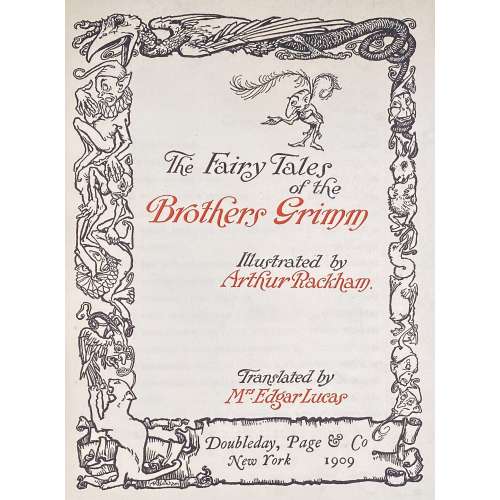 Title (black and red in pictorial frame): The Fairy Tales | of the | Brothers Grimm | Illustrated by Arthur Rackham. | Translated by | Mrs. Edgar Lucas | Doubleday, Page & Co | New York 1909. Pagination: [i-iv] – h.t., t.p., frontis., v-xv [xvi], 1-325 [326] colophon., [1 blank sheet], bfl; 40 tipped-in color plates (offset chromolithograph) with lettered guards, numerous in-text woodcuts. Collation: 4to; a-b4, A-2S4. Edition: 1st deluxe American large-paper edition, limited to 50 copies, Rackham’s facsimile signature to h.t. verso. Binding: Original full limp suede binding with yapp edges, gilt-ornamented and lettered spine. Top edge gilt, other uncut. Moiré endpapers. Printed on laid paper. Marbled endpapers.
Title (black and red in pictorial frame): The Fairy Tales | of the | Brothers Grimm | Illustrated by Arthur Rackham. | Translated by | Mrs. Edgar Lucas | Doubleday, Page & Co | New York 1909. Pagination: [i-iv] – h.t., t.p., frontis., v-xv [xvi], 1-325 [326] colophon., [1 blank sheet], bfl; 40 tipped-in color plates (offset chromolithograph) with lettered guards, numerous in-text woodcuts. Collation: 4to; a-b4, A-2S4. Edition: 1st deluxe American large-paper edition, limited to 50 copies, Rackham’s facsimile signature to h.t. verso. Binding: Original full limp suede binding with yapp edges, gilt-ornamented and lettered spine. Top edge gilt, other uncut. Moiré endpapers. Printed on laid paper. Marbled endpapers. -
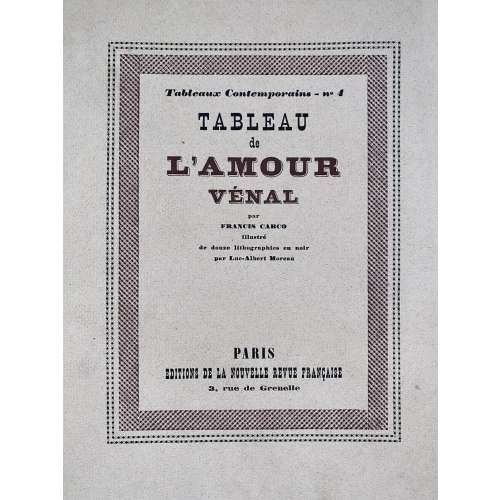 Description: Softcover, French flapped wrappers, lettered front, back (advert.) and spine, collated in-4to, 24.3 x 20.2 cm, printed on thick wove paper Vélin pur fil Lafuma-Navarre, print run limited to 335 copies from which this is copy № 219; outer margin untrimmed, some leaves uncut, glassine DJ. Limitation: 1 copy (A) on Japon Impérial + double suite of plates + suite of original drawings, 4 copies (B-E) on Japon Impérial + double suite of plates, 15 copies on on Japon Impérial + suite of plates on Vieux Japon teinté (F-T), 315 copies on Vélin pur fil Lafuma-Navarre, of which 15 (I-XV) not for sale. Copyright: Libraire Gallimard, 1924. Printed: March 10, 1924 – text by Coulouma (Argenteuil) under direction of H. Barthélemy, lithographs printed by Marchizet (Paris). Front wrapper (in letterpress two-colour border): Tableaux Contemporains – no 4 | . TABLEAU | de | L'AMOUR | VÉNAL | par | FRANCIS CARCO | Illustré | de douze lithographies en noir | par Luc-Albert Moreau | PARIS | ÉDITIONS DE LA NOUVELLE REVUE FRANÇAISE | 3, rue de Grenelle || Title-page: Same, without a frame, in black, L'AMOUR | VÉNAL in brown. Collation: 4to; 14 a4 2-164, total 68 leaves with wrappers included in collation plus 12 plates, incl. frontispiece, extraneous to collation. Pagination: [2 wrapper] [6] [i] ii-vii [viii blank] [9] 10-122 [2 colophon] [2 blank] [2 wrapper]; total 136 pages incl. wrappers, plus ils. Contributors: Francis Carco [François Carcopino-Tusoli] (French, 1886 – 1958) – author. Luc-Albert Moreau (French, 1882 – 1948) – artist. La Nouvelle Revue Française (nrf) (Paris)– publisher. Gaston Gallimard (French, 1881 – 1975) – publisher.
Description: Softcover, French flapped wrappers, lettered front, back (advert.) and spine, collated in-4to, 24.3 x 20.2 cm, printed on thick wove paper Vélin pur fil Lafuma-Navarre, print run limited to 335 copies from which this is copy № 219; outer margin untrimmed, some leaves uncut, glassine DJ. Limitation: 1 copy (A) on Japon Impérial + double suite of plates + suite of original drawings, 4 copies (B-E) on Japon Impérial + double suite of plates, 15 copies on on Japon Impérial + suite of plates on Vieux Japon teinté (F-T), 315 copies on Vélin pur fil Lafuma-Navarre, of which 15 (I-XV) not for sale. Copyright: Libraire Gallimard, 1924. Printed: March 10, 1924 – text by Coulouma (Argenteuil) under direction of H. Barthélemy, lithographs printed by Marchizet (Paris). Front wrapper (in letterpress two-colour border): Tableaux Contemporains – no 4 | . TABLEAU | de | L'AMOUR | VÉNAL | par | FRANCIS CARCO | Illustré | de douze lithographies en noir | par Luc-Albert Moreau | PARIS | ÉDITIONS DE LA NOUVELLE REVUE FRANÇAISE | 3, rue de Grenelle || Title-page: Same, without a frame, in black, L'AMOUR | VÉNAL in brown. Collation: 4to; 14 a4 2-164, total 68 leaves with wrappers included in collation plus 12 plates, incl. frontispiece, extraneous to collation. Pagination: [2 wrapper] [6] [i] ii-vii [viii blank] [9] 10-122 [2 colophon] [2 blank] [2 wrapper]; total 136 pages incl. wrappers, plus ils. Contributors: Francis Carco [François Carcopino-Tusoli] (French, 1886 – 1958) – author. Luc-Albert Moreau (French, 1882 – 1948) – artist. La Nouvelle Revue Française (nrf) (Paris)– publisher. Gaston Gallimard (French, 1881 – 1975) – publisher. -
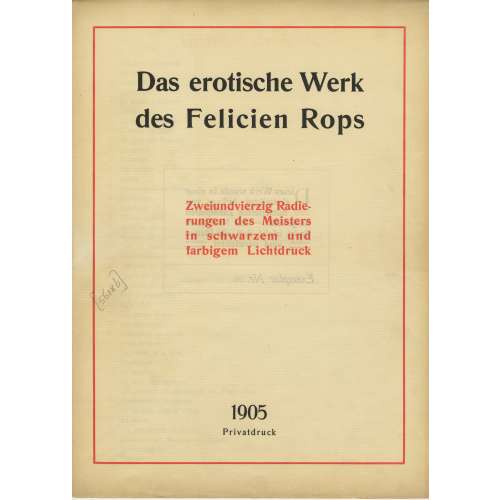
A limited-edition (№26/500) set of 42 etchings and drypoints after Félicien Rops (Belgian, 1833 – 1898), each mounted in a numbered passe-partout, printed posthumously by an anonym in Germany in 1905; in a flapped half faux suede-backed cardboard portfolio with straps, 442 x 335 mm, red embossed lettering to the front cover, bookplate of Richard Teschner (Austrian, 1879 – 1948) pasted inside.
Title-page (in a red frame): Das erotische Werk | des Felicien Rops | Zweiundvierzig Radie- | rungen des Meisters | in schwarzem und | farbigem Lichtdruck | 1905 | Privatdruk ||
Limitation (in a red two-section frame) : Dieses Werk wurde in einer | einmaligen Auflage von | 500 numerierten Exemplaren | hergestellt. — Ein Nachdruck | findet nicht statt, die Platten | == sind vernichtet == | Exemplar Nr. 26 ||
Verzeichnis der Tafeln (Table of Contents): 1. Initiation sentimentale; 2. La croix; 3. Entre-acte; 4. Holocauste; 5. La bonne hollandaise; 6. Étude; 7. La femme au pantin; 8. L’amour de Satan; 9. Au pays des féminies; 10. La volupté; 11. Evocation; 12. De castitate; 13. Joujou; 14. Vengeance d’une femme; 15. Phantasies; 16. Indolence; 17. Théâtre gaillard; 18. Appel au peuple; 19. Masques modernes; 20. Tout est grand chez les rois; 21. Marie-Madeleine; 22. L’amante du Christ; 23. Feuille de vigne; 24. La messe de Guide; 25 Viol et prostitution; 26. Le maillot; 27. Les jeunes France; 28. Les diaboliques; 29. Coquetterie au miroir; 30. Jeune homme; 31. La femme et la mort; 32. Confidence; 33. La bergère; 34. La mère aux satyrions; 35. Les exercices de dévotion de Mr. Henri Roch; 36. Mademoiselle de Maupin; 37. Le bonheur dans le crime; 38. La sirène; 39. Les cabotinages de l’amour; 40. Document sur l’impuissance d’aimer; 41. A cœur perdu; 42. Curieuse.
-
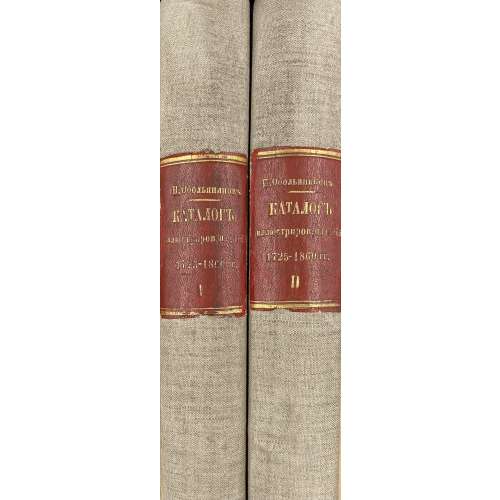 Two volumes, 32 x 24 cm each, uniformly bound in grey cloth with crimson morocco labels with gilt lettering to spine “Н. Обольяниновъ | КАТАЛОГЪ | иллюстриров. изданiй | 1725-1860 гг. | I (II)”, original wrappers preserved. To t.p. verso ink stamps “Latvijas PSR Zinātn̦u akadēmija Fundamentālā bibliotēka”, “1964”, “KATALOGS”, and “Z.A.B. Inv. № 80274”. Printed on laid paper, pagination throughout. 3,038 items with bibliographical descriptions. Title-page: КАТАЛОГЪ | РУССКИХЪ ИЛЛЮСТРИРОВАННЫХЪ | ИЗДАНIЙ | 1725—1860 гг. | — | СОСТАВИЛЪ | Н. Обольяниновъ. | Въ двухъ томахъ | Т. I (II). | ~ | МОСКВА – 1914 (1915). | Товарищество ТИПОГРАФIИ А. И. МАМОНТОВА, | Арбатская пл., Филипповский пер., д. № 11. || Vol. I: Collation: π6 1-424, total 174 leaves; pp.: [i-v] vi-xii, [1] 2-335 [336 errata] (total 348 pages); within green publisher’s wrappers. Vol. II: π2 1-444, total 178 leaves; pp.: [4] [337] 338-686 [687 errata], [688 blank] (total 356 pages); within green publisher’s wrappers. Provenance: Fundamental library of the Latvian Academy of Sciences. Contributors: Николай Александрович Обольянинов (Russian, 1868 – 1916) – author. Анатолий Иванович Ма́монтов (Russian, 1839 – 1905) – publisher.
Two volumes, 32 x 24 cm each, uniformly bound in grey cloth with crimson morocco labels with gilt lettering to spine “Н. Обольяниновъ | КАТАЛОГЪ | иллюстриров. изданiй | 1725-1860 гг. | I (II)”, original wrappers preserved. To t.p. verso ink stamps “Latvijas PSR Zinātn̦u akadēmija Fundamentālā bibliotēka”, “1964”, “KATALOGS”, and “Z.A.B. Inv. № 80274”. Printed on laid paper, pagination throughout. 3,038 items with bibliographical descriptions. Title-page: КАТАЛОГЪ | РУССКИХЪ ИЛЛЮСТРИРОВАННЫХЪ | ИЗДАНIЙ | 1725—1860 гг. | — | СОСТАВИЛЪ | Н. Обольяниновъ. | Въ двухъ томахъ | Т. I (II). | ~ | МОСКВА – 1914 (1915). | Товарищество ТИПОГРАФIИ А. И. МАМОНТОВА, | Арбатская пл., Филипповский пер., д. № 11. || Vol. I: Collation: π6 1-424, total 174 leaves; pp.: [i-v] vi-xii, [1] 2-335 [336 errata] (total 348 pages); within green publisher’s wrappers. Vol. II: π2 1-444, total 178 leaves; pp.: [4] [337] 338-686 [687 errata], [688 blank] (total 356 pages); within green publisher’s wrappers. Provenance: Fundamental library of the Latvian Academy of Sciences. Contributors: Николай Александрович Обольянинов (Russian, 1868 – 1916) – author. Анатолий Иванович Ма́монтов (Russian, 1839 – 1905) – publisher. -
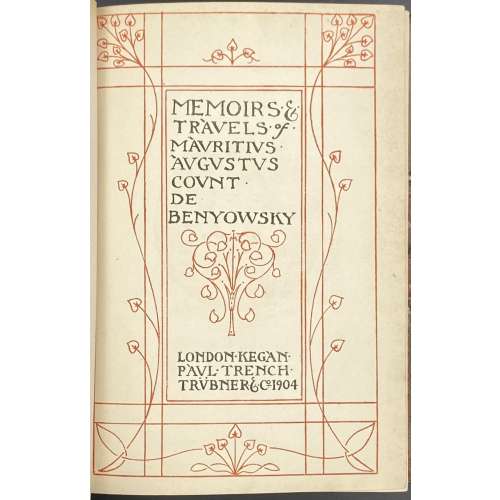 Title: MEMOIRS AND TRAVELS | OF | MAURITIUS AUGUSTUS COUNT DE | BENYOWSKY | MAGNATE OF THE KINGDOMS OF HUNGARY AND POLAND, ONE OF | THE CHIEFS OF THE CONFEDERATION OF POLAND | ETC., ETC. | Consisting of his Military Operations in Poland, his Exile into Kamchatka, | his Escape and Voyage from that Peninsula through the Northern | Pacific Ocean, touching at Japan and Formosa, to Canton | in China, with an Account of the French Settle- | ment he was appointed to form upon the | Island of Madagascar | WITH AN INTRODUCTION, NOTES AND BIBLIOGRAPHY | BY | CAPTAIN S. PASFIELD OLIVER || Half-title (ornamental, in black and red): MEMOIRS & | TRAVELS of | MAURITIUS | AUGUSTUS | COUNT | DE | BENYOWSKY | LONDON•KEGAN• | PAUL•TRENCH• | TRÜBNER•&•Co 1904 || Pagination: [i, ii] – owner pasted wood engraving “A woman of Kamchatka” / Dryden House advert., [iii, iv] – serial title / MAB (years), frontis. Portrait of MAB by Walter L. Colls w/guard, [v, vi] – ornamental h.t / copyright, [vii, viii] – t.p. / list of ill., ix-xxxvi, 1-635 [636]. Collation: 2 blank leaves (binding), [a]-b8 c2 1-398 406, 2 plates, 2 blank leaves (binding). Binding: Modern ¾ morocco over marbled boards, raised bands, gilt fleur-de-lis-cross in compartments, burgundy label with gilt lettering, by Atkinson Book Binders, Salisbury (sticker to back pastedown). Contributors: Printed by Neill and Co., Edinburgh. Published by Kegan Paul, Trench, Trübner & Co.; Kegan Paul, Charles (British, 1828 – 1902). Author: Maurice Auguste comte de Benyowsky [Мориц Август Бенёвский] (Polish-Slovak-Hungarian, 1746 –1786). Editor: Samuel Pasfield Oliver (British, 1838 – 1907). Translator: William Nicholson (British, 1753 – 1815). Originally published in 1790, in London (I have not seen it anywhere) and in Dublin by P. Wogan [etc.], and in 1791 in French, in Paris by Buisson.
Title: MEMOIRS AND TRAVELS | OF | MAURITIUS AUGUSTUS COUNT DE | BENYOWSKY | MAGNATE OF THE KINGDOMS OF HUNGARY AND POLAND, ONE OF | THE CHIEFS OF THE CONFEDERATION OF POLAND | ETC., ETC. | Consisting of his Military Operations in Poland, his Exile into Kamchatka, | his Escape and Voyage from that Peninsula through the Northern | Pacific Ocean, touching at Japan and Formosa, to Canton | in China, with an Account of the French Settle- | ment he was appointed to form upon the | Island of Madagascar | WITH AN INTRODUCTION, NOTES AND BIBLIOGRAPHY | BY | CAPTAIN S. PASFIELD OLIVER || Half-title (ornamental, in black and red): MEMOIRS & | TRAVELS of | MAURITIUS | AUGUSTUS | COUNT | DE | BENYOWSKY | LONDON•KEGAN• | PAUL•TRENCH• | TRÜBNER•&•Co 1904 || Pagination: [i, ii] – owner pasted wood engraving “A woman of Kamchatka” / Dryden House advert., [iii, iv] – serial title / MAB (years), frontis. Portrait of MAB by Walter L. Colls w/guard, [v, vi] – ornamental h.t / copyright, [vii, viii] – t.p. / list of ill., ix-xxxvi, 1-635 [636]. Collation: 2 blank leaves (binding), [a]-b8 c2 1-398 406, 2 plates, 2 blank leaves (binding). Binding: Modern ¾ morocco over marbled boards, raised bands, gilt fleur-de-lis-cross in compartments, burgundy label with gilt lettering, by Atkinson Book Binders, Salisbury (sticker to back pastedown). Contributors: Printed by Neill and Co., Edinburgh. Published by Kegan Paul, Trench, Trübner & Co.; Kegan Paul, Charles (British, 1828 – 1902). Author: Maurice Auguste comte de Benyowsky [Мориц Август Бенёвский] (Polish-Slovak-Hungarian, 1746 –1786). Editor: Samuel Pasfield Oliver (British, 1838 – 1907). Translator: William Nicholson (British, 1753 – 1815). Originally published in 1790, in London (I have not seen it anywhere) and in Dublin by P. Wogan [etc.], and in 1791 in French, in Paris by Buisson. -
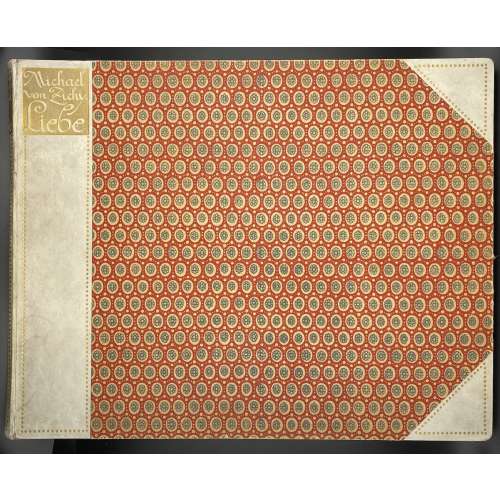 Oblong album of forty photogravures printed on wove paper in sanguine after drawings by Mihály Zichy; 31.5 x 40.5 cm gilt-decorated half-parchment over red boards with a gilt diaper design; embossed gilt label in the top left corner “Michael | von Zichy. | Liebe”. Anonymous edition. Bookplate to front pastedown: “P•U•H | EX | LIBRIS”. Photogravures made from the original watercolours and crayon drawings produced in 1874-1879; the original album consisted of 51 compositions was sold at Christie’s sale of Gérard Nordmann collection on December 14-15, 2006 in Paris. Some of these photogravures were reproduced photomechanically and printed in 1869 [LIB-2244.2019] and 1989 [LIB-2242.2019]. Limitation: 300 copies were privately printed in Leipzig in 1911 for subscribers only; photogravure copper plates were destroyed. This is copy № 285. Title-page (brown and black): MICHAEL VON ZICHY | LIEBE | VIERZIG ZEICHNUNGEN | PRIVATDRUCK LEIPZIG 1911 || Dimensions: album: 31.5 x 40.5 cm; sheets 31 x 40 cm, uncut. Catalogue raisonné: Bibliothèque érotique: Gérard Nordmann; Livres, manuscrits, dessins, photographies du XVIe au XXe siècle / Catalogues de ventes, seconde partie. — Paris: Christie’s, 2006; p. 280, № 564 (drawings); № 565 photogravures [LIB-2810.2021]. Contributors: Mihály Zichy [Michael von Zichy; Михаил Александрович Зичи] (Hungarian, 1827 – 1906).
Oblong album of forty photogravures printed on wove paper in sanguine after drawings by Mihály Zichy; 31.5 x 40.5 cm gilt-decorated half-parchment over red boards with a gilt diaper design; embossed gilt label in the top left corner “Michael | von Zichy. | Liebe”. Anonymous edition. Bookplate to front pastedown: “P•U•H | EX | LIBRIS”. Photogravures made from the original watercolours and crayon drawings produced in 1874-1879; the original album consisted of 51 compositions was sold at Christie’s sale of Gérard Nordmann collection on December 14-15, 2006 in Paris. Some of these photogravures were reproduced photomechanically and printed in 1869 [LIB-2244.2019] and 1989 [LIB-2242.2019]. Limitation: 300 copies were privately printed in Leipzig in 1911 for subscribers only; photogravure copper plates were destroyed. This is copy № 285. Title-page (brown and black): MICHAEL VON ZICHY | LIEBE | VIERZIG ZEICHNUNGEN | PRIVATDRUCK LEIPZIG 1911 || Dimensions: album: 31.5 x 40.5 cm; sheets 31 x 40 cm, uncut. Catalogue raisonné: Bibliothèque érotique: Gérard Nordmann; Livres, manuscrits, dessins, photographies du XVIe au XXe siècle / Catalogues de ventes, seconde partie. — Paris: Christie’s, 2006; p. 280, № 564 (drawings); № 565 photogravures [LIB-2810.2021]. Contributors: Mihály Zichy [Michael von Zichy; Михаил Александрович Зичи] (Hungarian, 1827 – 1906). -
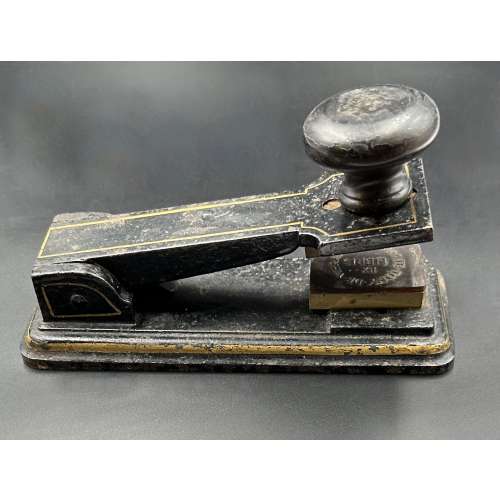 Iron pliers painted black and outlined in gilt lacquer, with wooden handle and bronze seals, "Ex Libris Comte Tony de Vibraye", L17.1 x W6.9 x H7.5 cm. Provenance: Antoine Henri Gaston Hurault de Vibraye [Comte Tony de Vibraye] (French, 1893 – 1951). The book with such a stamp in this library: [LIB-3243.2023] Crébillon fils. La Nuit et le moment ou Les Matinées de Cythère / Illustrations de Sylvain Sauvage. — Paris: Au dépens d’un amateur, 1924.
Iron pliers painted black and outlined in gilt lacquer, with wooden handle and bronze seals, "Ex Libris Comte Tony de Vibraye", L17.1 x W6.9 x H7.5 cm. Provenance: Antoine Henri Gaston Hurault de Vibraye [Comte Tony de Vibraye] (French, 1893 – 1951). The book with such a stamp in this library: [LIB-3243.2023] Crébillon fils. La Nuit et le moment ou Les Matinées de Cythère / Illustrations de Sylvain Sauvage. — Paris: Au dépens d’un amateur, 1924. -
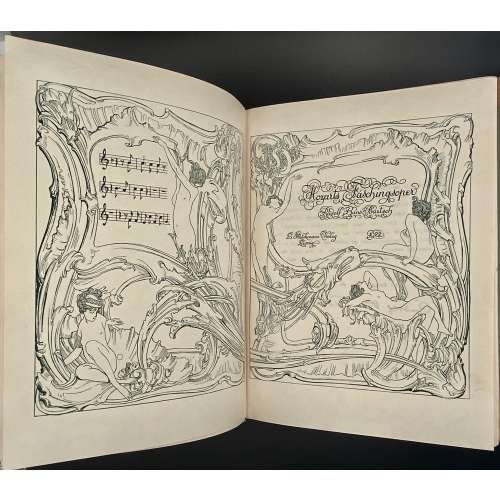 Of the limited edition of 1150 copies, this is №54 (on Japan paper, signed by Bartsch and by von Bayros). Owner's binding imitating quarter-morocco, a red label with gilt lettering to spine (possibly by Ms Hunt, who was an amateur bookbinder). Bookplate on front pastedown: "Ex libris Rachel McMasters Miller Hunt | S. B. Hill Dec 1913 | A.J. Downey Sc." Alfred James Downey (1882-1944). Rachel McMasters Miller Hunt (1882-1963). Sarah B. Hill had done lettering for Ms Hunt. On back pastedown: Stamp "Hunt Libraries CMU" and sticker "Gotham Book Mart | 128 West 45th street | New York". This is from an edition of Carcassonne:
Of the limited edition of 1150 copies, this is №54 (on Japan paper, signed by Bartsch and by von Bayros). Owner's binding imitating quarter-morocco, a red label with gilt lettering to spine (possibly by Ms Hunt, who was an amateur bookbinder). Bookplate on front pastedown: "Ex libris Rachel McMasters Miller Hunt | S. B. Hill Dec 1913 | A.J. Downey Sc." Alfred James Downey (1882-1944). Rachel McMasters Miller Hunt (1882-1963). Sarah B. Hill had done lettering for Ms Hunt. On back pastedown: Stamp "Hunt Libraries CMU" and sticker "Gotham Book Mart | 128 West 45th street | New York". This is from an edition of Carcassonne:
-
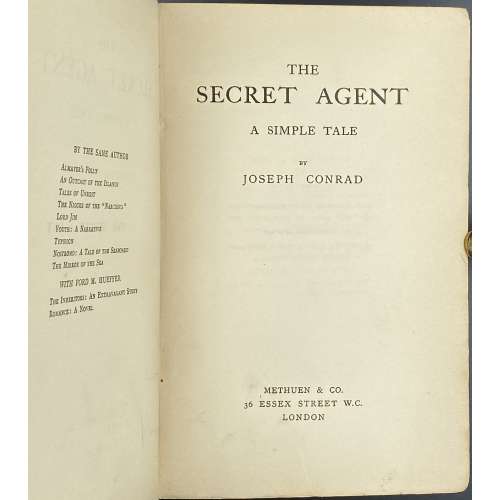 Title page: THE | SECRET AGENT | A SIMPLE TALE | BY | JOSEPH CONRAD | METHUEN & CO. | 36 ESSEX STREET W.C. | LONDON || Imprint on t.p. verso: First Published in 1907 Dedication: To H. G. Wells. Pagination: [2] – blank, [6] – h.t., t.p., dedication; 1-442, [2] colophon: THE RIVERSIDE PRESS LIMITED, EDINBURGH / blank; [1-2] 3-40 – Catalogue of books published by Methuen and company, September 1907; total 492 pages. Collation: 8vo; π4, A-Z8 2A-2D8, 2E6, + 20 leaves of advertisement: signed A2 on leaf 5 and A3 on leaf 9, other unsigned, 2E2 signed; total 246 leaves. Binding: Publisher’s burgundy cloth with gilt lettering and elements to spine, lower margin untrimmed, 19.5 x 13.5 cm. Edition: 1st edition, 1st printing ("be be" on the last line of page 117) of 2,500 copied printed. Contributors: Conrad, Joseph (Polish-British, 1857 – 1924) – author. Methuen & Co. (London) – publisher. The Riverside Press Limited (Edinburgh) – printer. Herbert George Wells (British, 1866 – 1946) – dedicatee.
Title page: THE | SECRET AGENT | A SIMPLE TALE | BY | JOSEPH CONRAD | METHUEN & CO. | 36 ESSEX STREET W.C. | LONDON || Imprint on t.p. verso: First Published in 1907 Dedication: To H. G. Wells. Pagination: [2] – blank, [6] – h.t., t.p., dedication; 1-442, [2] colophon: THE RIVERSIDE PRESS LIMITED, EDINBURGH / blank; [1-2] 3-40 – Catalogue of books published by Methuen and company, September 1907; total 492 pages. Collation: 8vo; π4, A-Z8 2A-2D8, 2E6, + 20 leaves of advertisement: signed A2 on leaf 5 and A3 on leaf 9, other unsigned, 2E2 signed; total 246 leaves. Binding: Publisher’s burgundy cloth with gilt lettering and elements to spine, lower margin untrimmed, 19.5 x 13.5 cm. Edition: 1st edition, 1st printing ("be be" on the last line of page 117) of 2,500 copied printed. Contributors: Conrad, Joseph (Polish-British, 1857 – 1924) – author. Methuen & Co. (London) – publisher. The Riverside Press Limited (Edinburgh) – printer. Herbert George Wells (British, 1866 – 1946) – dedicatee. -
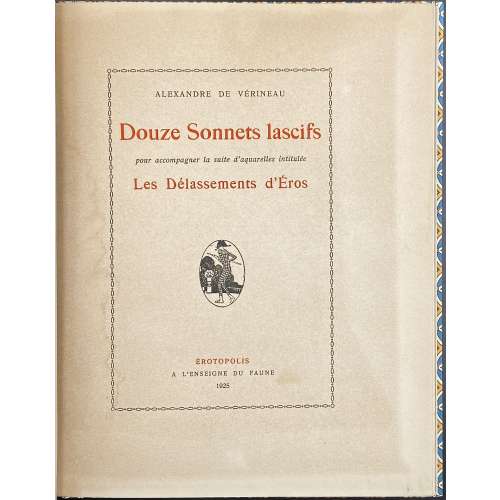 Volume bound by Boichot (signed on front pastedown), 25.3 x 20.2 cm in a 25.9 x 20.3 slipcase, the book and the case uniformly in beige, brown, and blue diaper paper with a navy blue label with gilt lettering to book's spine, top edge gilt, J.-P. Dutel’s bookplate to fep, portfolio cover preserved. Pp.: [1-4] 5-37 [38 blank]; collated 4to, 13 2-54; total 19 leaves (38 pages), plus 12 plates coloured in stencil technique (pochoir), produced after watercolours by Gerda Wegener in c. 1917 on Arches or Whatman laid paper, watermarked. Each illustration bears a small masquerade mask at the bottom as a signature. Text printed on laid paper without a watermark; starting from 2nd gathering, the text printed on recto only; minor traces of water stain to some pages. Title-page (red and black): ALEXANDRE DE VÉRINEAU | Douze Sonnets lascifs | pour accompagner la suite d’aquarelles intitulée | Les Délassements d’Éros | {vignette medallion} | ÉROTOPOLIS | A L’ENSEIGNE DU FAUNE | 1925 || First edition, first printing (incl. plates); clandestine. Catalogue raisonné: Dutel 1356, 1434; Pia 363/4; Noedmann I 310; Fekete 221. Contributors: Louis Perceau (French, 1883 – 1942) – author (see LIB-2633.2021: Guillaume Apollinaire, Fernand Fleuret, Louis Perceau. L'enfer de la Bibliothèque Nationale. — Paris: Mercure de France, 1913). Gerda Wegener (Danish, 1886 – 1940) – artist. Maurice Duflou (French, 1885 – 1951) – publisher. Boichot – bookbinder.
Volume bound by Boichot (signed on front pastedown), 25.3 x 20.2 cm in a 25.9 x 20.3 slipcase, the book and the case uniformly in beige, brown, and blue diaper paper with a navy blue label with gilt lettering to book's spine, top edge gilt, J.-P. Dutel’s bookplate to fep, portfolio cover preserved. Pp.: [1-4] 5-37 [38 blank]; collated 4to, 13 2-54; total 19 leaves (38 pages), plus 12 plates coloured in stencil technique (pochoir), produced after watercolours by Gerda Wegener in c. 1917 on Arches or Whatman laid paper, watermarked. Each illustration bears a small masquerade mask at the bottom as a signature. Text printed on laid paper without a watermark; starting from 2nd gathering, the text printed on recto only; minor traces of water stain to some pages. Title-page (red and black): ALEXANDRE DE VÉRINEAU | Douze Sonnets lascifs | pour accompagner la suite d’aquarelles intitulée | Les Délassements d’Éros | {vignette medallion} | ÉROTOPOLIS | A L’ENSEIGNE DU FAUNE | 1925 || First edition, first printing (incl. plates); clandestine. Catalogue raisonné: Dutel 1356, 1434; Pia 363/4; Noedmann I 310; Fekete 221. Contributors: Louis Perceau (French, 1883 – 1942) – author (see LIB-2633.2021: Guillaume Apollinaire, Fernand Fleuret, Louis Perceau. L'enfer de la Bibliothèque Nationale. — Paris: Mercure de France, 1913). Gerda Wegener (Danish, 1886 – 1940) – artist. Maurice Duflou (French, 1885 – 1951) – publisher. Boichot – bookbinder. -
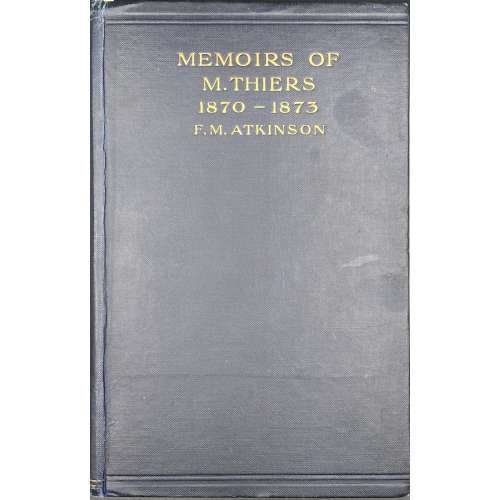 Title: MEMOIRS OF M. THIERS | 1870—1873 | Translated by | F. M. ATKINSON | {publisher’s device} | LONDON: GEORGE ALLEN & UNWIN LTD. | RUSKIN HOUSE 40 MUSEUM STREET, W.C. Pagination: [6] 7-384. Collation: 8vo; [1]-248. Size: 23 x 15 cm Binding: Blue cloth, top and bottom ruled in blind, gilt lettering to front cover and spine. Original: Adolphe Thiers. Notes et souvenirs de M. Thiers, 1870-1873: voyage diplomatique, proposition d'un armistice, préliminaires de la paix, présidence de la République. — Paris : [s.n.], 1901. — 465 p. The preface and editing signed "F. D." [Félicie Dosne]. Félicie Dosne (French, 1823 – 1906) was Thiers's sister-in-law.
Title: MEMOIRS OF M. THIERS | 1870—1873 | Translated by | F. M. ATKINSON | {publisher’s device} | LONDON: GEORGE ALLEN & UNWIN LTD. | RUSKIN HOUSE 40 MUSEUM STREET, W.C. Pagination: [6] 7-384. Collation: 8vo; [1]-248. Size: 23 x 15 cm Binding: Blue cloth, top and bottom ruled in blind, gilt lettering to front cover and spine. Original: Adolphe Thiers. Notes et souvenirs de M. Thiers, 1870-1873: voyage diplomatique, proposition d'un armistice, préliminaires de la paix, présidence de la République. — Paris : [s.n.], 1901. — 465 p. The preface and editing signed "F. D." [Félicie Dosne]. Félicie Dosne (French, 1823 – 1906) was Thiers's sister-in-law. -
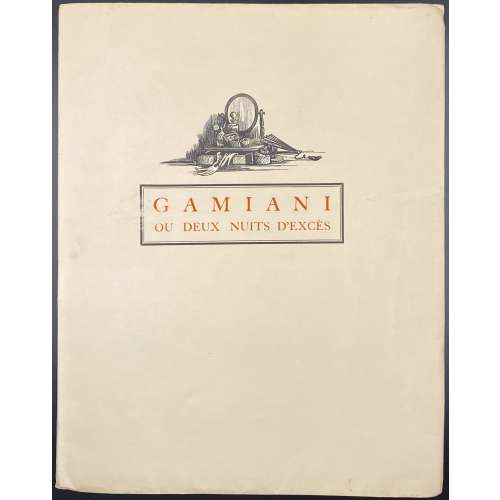 Description: Softcover volume 27 x 21.3 cm in publisher’s French flapped cream wrappers, with a vignette and lettered in red within a black frame to front "GAMIANI | OU DEUX NUITS D'EXCÈS". Printed on unmarked wove paper, outer and lower margins untrimmed. Illustrated with full-page frontispiece, 10 headpieces, and 5 smaller woodcuts (one repeated on the front wrapper and on t.p.) by Pierre Aubert after Jean-Gabriel Daragnès [pseud. Jean de Guethary], some with inlaid tissue guards. Copy enriched with one graphite pencil drawing signed "J. de Guethary", tipped in before h.t. Title-page (red and black): GAMIANI | OU DEUX NUITS D'EXCÈS | PAR A. DE M. | Avec | des vignettes | de | JEAN DE GUETHARY | {VIGNETTE} | — | CHEZ UN BOURGEOIS DE PARIS | Rue du Coq Hardi | 1845 || Pagination: [i-vi] (orig. drawing, h.t. / vignette, t.p./limit.) [vii] viii-xx, [1-3] 4-64 [4]; total 88 pages. Limitation: Edition limited to 110 copies. According to Dutel, 110 copies were printed on Japon ancient, 3 on Japon Impérial, and 3 on Whatman. This copy is № 115. Catalogue raisonné: Dutel (1920-1970): № 1630, p. 183; Pia (Enfer) 527, p. 286. Alfred de Musset (French, 1810 – 1857) – author. Jean-Gabriel Daragnès (French, 1886 – 1950) – artist, publisher. Pierre Aubert (Swiss, 1910 – 1987) – engraver.
Description: Softcover volume 27 x 21.3 cm in publisher’s French flapped cream wrappers, with a vignette and lettered in red within a black frame to front "GAMIANI | OU DEUX NUITS D'EXCÈS". Printed on unmarked wove paper, outer and lower margins untrimmed. Illustrated with full-page frontispiece, 10 headpieces, and 5 smaller woodcuts (one repeated on the front wrapper and on t.p.) by Pierre Aubert after Jean-Gabriel Daragnès [pseud. Jean de Guethary], some with inlaid tissue guards. Copy enriched with one graphite pencil drawing signed "J. de Guethary", tipped in before h.t. Title-page (red and black): GAMIANI | OU DEUX NUITS D'EXCÈS | PAR A. DE M. | Avec | des vignettes | de | JEAN DE GUETHARY | {VIGNETTE} | — | CHEZ UN BOURGEOIS DE PARIS | Rue du Coq Hardi | 1845 || Pagination: [i-vi] (orig. drawing, h.t. / vignette, t.p./limit.) [vii] viii-xx, [1-3] 4-64 [4]; total 88 pages. Limitation: Edition limited to 110 copies. According to Dutel, 110 copies were printed on Japon ancient, 3 on Japon Impérial, and 3 on Whatman. This copy is № 115. Catalogue raisonné: Dutel (1920-1970): № 1630, p. 183; Pia (Enfer) 527, p. 286. Alfred de Musset (French, 1810 – 1857) – author. Jean-Gabriel Daragnès (French, 1886 – 1950) – artist, publisher. Pierre Aubert (Swiss, 1910 – 1987) – engraver. -
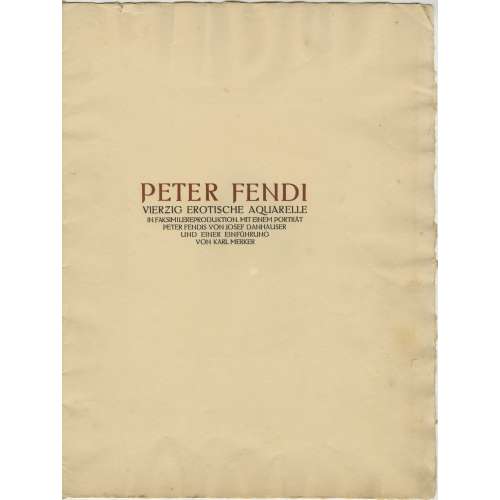 Six in-folio leaves, 2o, incl. title-page, engraved portrait of P. Fendi after Josef Danhauser, 4 pages of printed text, and 10 of 40 colour photomechanical reproductions of Fendi’s watercolour plates (205 x 140 mm), mounted on vellum paper with blind stamp (398 x 305 mm) in a parchment-backed flapped album (defective), gilt-stamped, with straps. Limited edition of 600 copies. The publisher is not stated but is sometimes attributed to C. W. Stern in Vienna. Limitation statement and imprint missing. Title-page (brown and black): PETER FENDI | VIERZIG EROTISCHE AQUARELLE | IN FAKSIMILEREPRODUKTION. MIT EINEM PORTRÄT | PETER FENDIS VON JOSEF DANHAUSER | UND EINER EINFÜHRUNG | VON KARL MERKER || Catalogue Raisonné: Nordmann II № 198, p.96. Contributors: Peter Fendi (Austrian, 1796 – 1842) Josef Danhauser (Austian, 1805 – 1845) Karl Merker – author/introduction.
Six in-folio leaves, 2o, incl. title-page, engraved portrait of P. Fendi after Josef Danhauser, 4 pages of printed text, and 10 of 40 colour photomechanical reproductions of Fendi’s watercolour plates (205 x 140 mm), mounted on vellum paper with blind stamp (398 x 305 mm) in a parchment-backed flapped album (defective), gilt-stamped, with straps. Limited edition of 600 copies. The publisher is not stated but is sometimes attributed to C. W. Stern in Vienna. Limitation statement and imprint missing. Title-page (brown and black): PETER FENDI | VIERZIG EROTISCHE AQUARELLE | IN FAKSIMILEREPRODUKTION. MIT EINEM PORTRÄT | PETER FENDIS VON JOSEF DANHAUSER | UND EINER EINFÜHRUNG | VON KARL MERKER || Catalogue Raisonné: Nordmann II № 198, p.96. Contributors: Peter Fendi (Austrian, 1796 – 1842) Josef Danhauser (Austian, 1805 – 1845) Karl Merker – author/introduction. -
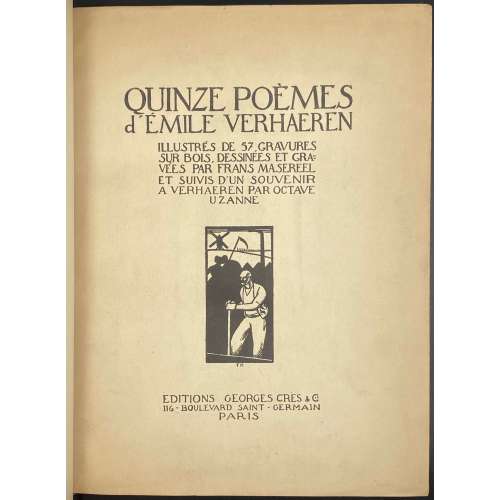 Quinze poèmes d'Emile Verhaeren. Illustrés de 57 gravures sur bois dessinées et gravées par Frans Masereel et suivis d'un 'Souvenir à Verhaeren' par Octave Uzanne. — Paris: Éditions Georges Crès, 1917. Authors: Emile Verhaeren (text), Frans Masereel (illustrations), Octave Uzanne (text). Publisher: Éditions Georges Crès. [Georges-Célestin Crès (1875 - 1935) was a French publisher and bookseller. Address: 116 boulevard Saint-Germain, Paris]. Printer: Sonor S.A. - Geneve, under the direction of Auguste Jordanis. The number of copies printed: 1555 of which 15 (1-15) on Japan paper, 190 (16-205) on Fabriano paper, and 1350 (206-1555) on English paper (1506-1555 not for trade). This copy № 1312. Pagination: [i] - front cover, [ii] - half-title, [iii] - title, [iv] - printrun justification, [v] - table of contents, [vi] - blank, [i-vii] viii-ciii, [civ] - printer statement, [cv] - back cover; one-side (recto) printing and pagination. Owner's contemporary red half-Morocco with marbled boards; spine with four raised bands, gilt lettering and design elements. Original printed paper wrappers preserved. Marbled endpapers. Trimmed unevenly.
Quinze poèmes d'Emile Verhaeren. Illustrés de 57 gravures sur bois dessinées et gravées par Frans Masereel et suivis d'un 'Souvenir à Verhaeren' par Octave Uzanne. — Paris: Éditions Georges Crès, 1917. Authors: Emile Verhaeren (text), Frans Masereel (illustrations), Octave Uzanne (text). Publisher: Éditions Georges Crès. [Georges-Célestin Crès (1875 - 1935) was a French publisher and bookseller. Address: 116 boulevard Saint-Germain, Paris]. Printer: Sonor S.A. - Geneve, under the direction of Auguste Jordanis. The number of copies printed: 1555 of which 15 (1-15) on Japan paper, 190 (16-205) on Fabriano paper, and 1350 (206-1555) on English paper (1506-1555 not for trade). This copy № 1312. Pagination: [i] - front cover, [ii] - half-title, [iii] - title, [iv] - printrun justification, [v] - table of contents, [vi] - blank, [i-vii] viii-ciii, [civ] - printer statement, [cv] - back cover; one-side (recto) printing and pagination. Owner's contemporary red half-Morocco with marbled boards; spine with four raised bands, gilt lettering and design elements. Original printed paper wrappers preserved. Marbled endpapers. Trimmed unevenly. -
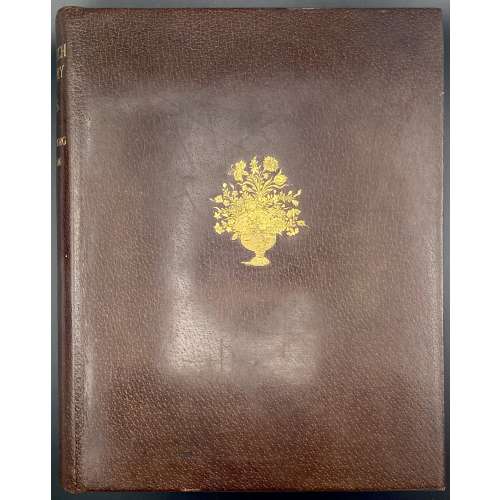 Title: OLD DUTCH | POTTERY AND TILES | BY ELISABETH | NEURDENBURG | LITT. D., READER IN THE HISTORY OF ART AT | THE UNIVERSITY OF GRONINGEN. TRANSLATED | WITH ANNOTATIONS BY | Bernard Rackham | DEPUTY KEEPER, DEPARTMENT | OF CERAMICS, VICTORIA AND | ALBERT MUSEUM | […] | WITH ONE HUNDRED AND TWELVE | ILLUSTRATIONS OF WHICH NINE | ARE IN COLOUR | LONDON: BENN BROTHERS, LIMITED | 8 BOUVERIE STREET, E.C. 4 | 1923 || Verso to half-title: Of this book 100 copies only for sale have been printed on English | hand-made paper, bound in pigskin and signed by the Authoress | and Translator. These copies also contain an extra colour plate. | This in Number “7” (in manuscript) | Two signatures (ink, manuscript) || Pagination: [i, ii] – h.t. / tirage, [iii, iv] – t.p. / imprint, [v, vi] – dedication to Dr. A. Pit / blank, vii-xv [xvi blank] [1, 2] 3-155 [156 blank], frontispiece (colour) and 59 leaves of plates (9 colour) with 112 figures, with lettered protective sheets. Collation: 4to in 8th; [A]8 [B]8 C-K8 L6; frontis., +59 leaves of plates. Binding: 30 x 24 cm, Full dark brown pigskin with gilt ornament to front board and gilt lettering to spine; printed on thick wove paper, top edge gilt, others untrimmed. Contributors: Neurdenburg, Elisabeth (Dutch, 1882 – 1957) – author [autograph]. Rackham, Bernard (British, 1876 – 1964) – translator [autograph]. Brendon, William (British, 1845 – 1928) – printer. Mayflower Press (Plymouth), William Brendon & Son, Ltd. – printer Benn Brothers Ltd. (British company, 1880 – 1987) Benn, Sir John, 1st Baronet (British, 1850 – 1922)
Title: OLD DUTCH | POTTERY AND TILES | BY ELISABETH | NEURDENBURG | LITT. D., READER IN THE HISTORY OF ART AT | THE UNIVERSITY OF GRONINGEN. TRANSLATED | WITH ANNOTATIONS BY | Bernard Rackham | DEPUTY KEEPER, DEPARTMENT | OF CERAMICS, VICTORIA AND | ALBERT MUSEUM | […] | WITH ONE HUNDRED AND TWELVE | ILLUSTRATIONS OF WHICH NINE | ARE IN COLOUR | LONDON: BENN BROTHERS, LIMITED | 8 BOUVERIE STREET, E.C. 4 | 1923 || Verso to half-title: Of this book 100 copies only for sale have been printed on English | hand-made paper, bound in pigskin and signed by the Authoress | and Translator. These copies also contain an extra colour plate. | This in Number “7” (in manuscript) | Two signatures (ink, manuscript) || Pagination: [i, ii] – h.t. / tirage, [iii, iv] – t.p. / imprint, [v, vi] – dedication to Dr. A. Pit / blank, vii-xv [xvi blank] [1, 2] 3-155 [156 blank], frontispiece (colour) and 59 leaves of plates (9 colour) with 112 figures, with lettered protective sheets. Collation: 4to in 8th; [A]8 [B]8 C-K8 L6; frontis., +59 leaves of plates. Binding: 30 x 24 cm, Full dark brown pigskin with gilt ornament to front board and gilt lettering to spine; printed on thick wove paper, top edge gilt, others untrimmed. Contributors: Neurdenburg, Elisabeth (Dutch, 1882 – 1957) – author [autograph]. Rackham, Bernard (British, 1876 – 1964) – translator [autograph]. Brendon, William (British, 1845 – 1928) – printer. Mayflower Press (Plymouth), William Brendon & Son, Ltd. – printer Benn Brothers Ltd. (British company, 1880 – 1987) Benn, Sir John, 1st Baronet (British, 1850 – 1922)


